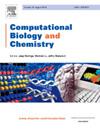协同抑制细胞生长:通过混合计算方法揭示靶向p53和MDM2的苯咪嗪衍生物。
IF 2.6
4区 生物学
Q2 BIOLOGY
引用次数: 0
摘要
由于遗传和表观遗传修饰,肺癌是男性和女性死亡的主要原因。我们的研究重点是通过基于功能基团的药物设计来制造苯咪嗪环,以抑制负责癌细胞生长的p53 -7A1W和MDM2-7AU9蛋白。设计了100个分子,并使用滑动坞平台结合在7A1W和7AU9蛋白的活性位点内,并进行寻找MMGBSA。通过100 ns的MD模拟分析和DFTB化学稳定性研究证实了其稳定性和相互作用。结果表明,氨基苯甲酸取代分子的最佳结合能为-8.16 kcal/mol, MD模拟头图表明,主要有9种氨基酸形成疏水和氢键相互作用。DFTB分析表明,苯咪嗪环衍生物的能隙为0.0508,表明其稳定性和较低的化学反应性。这些结果表明,苯咪嗪环衍生物将是一种较好的根除肺癌的先导分子。本文章由计算机程序翻译,如有差异,请以英文原文为准。
Synergistic suppression of cell growth: Phenmiazine derivatives targeting p53 and MDM2 unveiled through hybrid computational method
Lung cancer is the leading cause of mortality in both men and women due to genetic and epigenetic modifications. Our study focuses on fabricating phenmiazine ring leads by a functional group-based drug design to inhibit p53 −7A1W and MDM2–7AU9 proteins responsible for cancer cell growth. One hundred molecules are designed and allowed to bind inside the active site of 7A1W and 7AU9 protein using a glide dock platform and subjected to find MMGBSA. The stability and interaction were confirmed by MD simulation analysis at 100 ns and DFTB chemical stability study. The result gave the best binding energy of −8.16 kcal/mol for aminobenzoic acid substituted molecule and the MD simulation head map illustrates that majorly 9 amino acids form hydrophobic and h-bond interactions. DFTB analysis reveals the energy gaps of 0.0508 signifying stability and lower chemical reactivity of the Phenmiazine ring derivatives. These findings conclude that the Phenmiazine ring derivative will be a better lead molecule to eradicate lung cancer.
求助全文
通过发布文献求助,成功后即可免费获取论文全文。
去求助
来源期刊

Computational Biology and Chemistry
生物-计算机:跨学科应用
CiteScore
6.10
自引率
3.20%
发文量
142
审稿时长
24 days
期刊介绍:
Computational Biology and Chemistry publishes original research papers and review articles in all areas of computational life sciences. High quality research contributions with a major computational component in the areas of nucleic acid and protein sequence research, molecular evolution, molecular genetics (functional genomics and proteomics), theory and practice of either biology-specific or chemical-biology-specific modeling, and structural biology of nucleic acids and proteins are particularly welcome. Exceptionally high quality research work in bioinformatics, systems biology, ecology, computational pharmacology, metabolism, biomedical engineering, epidemiology, and statistical genetics will also be considered.
Given their inherent uncertainty, protein modeling and molecular docking studies should be thoroughly validated. In the absence of experimental results for validation, the use of molecular dynamics simulations along with detailed free energy calculations, for example, should be used as complementary techniques to support the major conclusions. Submissions of premature modeling exercises without additional biological insights will not be considered.
Review articles will generally be commissioned by the editors and should not be submitted to the journal without explicit invitation. However prospective authors are welcome to send a brief (one to three pages) synopsis, which will be evaluated by the editors.
 求助内容:
求助内容: 应助结果提醒方式:
应助结果提醒方式:


